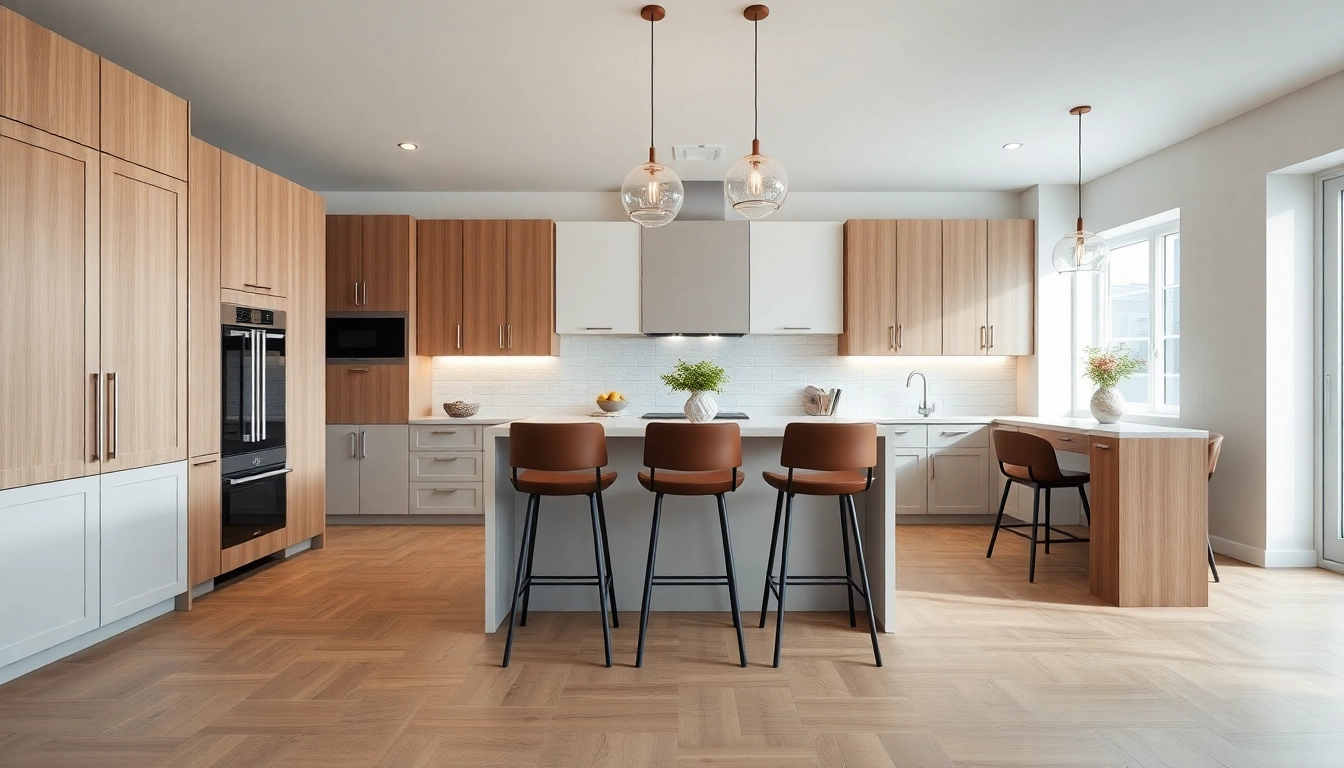Understanding Kitchen Remodels
The kitchen serves as the heart of the home, a multifunctional space for cooking, dining, and socializing. Given its importance, it’s no wonder that kitchen remodels are one of the most common home improvement projects undertaken by homeowners. Whether you’re looking to increase functionality, improve aesthetics, or enhance resale value, a kitchen remodel can transform your living space in many meaningful ways.
What Defines a Kitchen Remodel?
A kitchen remodel can range from minor updates, such as new cabinet hardware and paint, to major renovations that involve reconfiguring the layout, replacing appliances, and even changing the plumbing. Generally, a remodel is characterized by:
- Design Changes: Alterations to the kitchen layout or design, such as opening up the space to create an open floor plan.
- Structural Modifications: Changes to walls, windows, or doors, possibly requiring permits.
- Upgraded Appliances: Replacing older appliances with newer, more energy-efficient models.
- New Fixtures and Finishes: This includes modern lighting fixtures, countertops, cabinets, and flooring.
Common Motivations for Remodeling
Understanding why homeowners choose to remodel can provide valuable insights for your own kitchen renovation project. Here are some common motivations:
- Increased Functionality: As families grow, their needs evolve. A remodel can enhance storage and cooking efficiency.
- Improving Aesthetics: Outdated designs can diminish the appeal of a home. Homeowners often seek a fresh look that reflects current trends.
- Enhancing Value: A modern kitchen can significantly raise a home’s market value, making it more attractive to potential buyers.
- Personal Preferences: Remodeling allows individuals to customize their kitchens according to personal style and functionality.
Key Trends in Kitchen Design
The kitchen design landscape continues to evolve, driven by changing tastes and technological advancements. Here are some of the latest trends shaping kitchen remodels:
- Smart Kitchens: Technology integration, such as smart appliances and voice-activated systems, are becoming standard in modern kitchens.
- Sustainable Materials: Eco-friendly materials, such as bamboo, reclaimed wood, and recycled products, are gaining popularity as homeowners prioritize sustainability.
- Open Concept Designs: Many homeowners favor an open flow between the kitchen and living spaces, enhancing interaction and usability.
- Bold Color Choices: While neutral tones are still popular, many designs incorporate bold colors to make a statement.
Planning Your Kitchen Remodel
Successfully executing a kitchen remodel begins with meticulous planning. This process involves setting a realistic budget, identifying the right layout, and choosing essential features.
Setting a Realistic Budget for Kitchen Remodels
Establishing a budget is one of the first steps in planning a kitchen remodel. Here are key components to consider:
- Kitchen Size: The size of your kitchen directly impacts remodeling costs. Generally, medium to large kitchens require larger budgets.
- Scope of Renovation: If you’re making major changes, such as structural modifications, you’ll need to allocate a larger part of your budget to cover these costs.
- Material Quality: Higher-quality materials can increase upfront costs but often lead to better durability and performance.
- Labor Costs: Don’t forget to account for contractor fees, which can vary based on experience and the complexity of the project.
On average, homeowners spend between $32,574 and $77,939 on a kitchen remodel, according to industry research. Knowing your budget can help inform your decisions and prevent overspending.
Choosing the Right Layout
The kitchen layout is essential for functionality and flow. The choice of layout will depend on available space, personal preference, and workflow needs. Here are some popular kitchen layouts you may consider:
- U-Shaped: This layout features three walls of cabinetry, providing ample storage and a work-friendly area.
- L-Shaped: Perfect for larger spaces, the L-shaped kitchen allows for an open floor plan that encourages movement and interaction.
- Galley: The galley kitchen, or corridor kitchen, is ideal for smaller homes where space is limited.
- Island: Incorporating a kitchen island can provide additional workspace and serve as a central hub for socializing.
Essential Features to Consider
Beyond layout, consider the essential features that will enhance the usability of your kitchen. Here are some factors to think about:
- Storage Solutions: Custom cabinetry, pull-out shelves, and pantry units maximize storage and reduce clutter.
- Countertop Materials: Select surfaces that align with your lifestyle, budget, and aesthetic preferences; options include granite, quartz, and butcher block.
- Appliances: Choose appliances that suit your cooking habits. Energy-efficient models can save on utility bills outside of purchase costs.
- Lighting: Layered lighting, including task lighting over work areas and ambient lighting, enhances both functionality and atmosphere.
Executing Your Kitchen Remodel
Once you’ve laid the groundwork, it’s time to move from planning to execution. This stage involves selecting the right contractors, obtaining necessary permits, and creating timelines to keep the project on track.
Finding Trusted Contractors
Choosing the right contractor is vital to ensuring your kitchen remodel goes smoothly. Here are steps to help you find a trusted professional:
- Research: Look for local contractors with extensive experience in kitchen remodels. Online reviews and referrals from friends can provide valuable insights.
- Interview Candidates: Speak with multiple contractors to understand their approach and capabilities. Ask for portfolios from previous projects to assess their style and quality of work.
- Get written estimates: Obtain detailed quotes that outline costs for labor and materials. This transparency is crucial for budget management.
Having the right support can make a significant difference in the project’s success. Ensure that your contractors are licensed and insured to protect both parties during the remodel.
Permits and Regulations
Before starting any construction work, it’s important to understand and comply with local building codes and regulations. This may require obtaining a permit for significant changes, such as structural modifications or electrical and plumbing work. Steps to navigate permits include:
- Consulting Local Authorities: Check with your city or county to determine which permits are necessary based on your project scope.
- Documentation: Be prepared to submit plans and potentially attend meetings or inspections as part of the approval process.
Failure to obtain the proper permits can lead to fines and complications down the road, underscoring the importance of this step.
Timelines and Scheduling
Establishing a timeline for your remodel helps ensure the project stays on track. Consider the following when creating a schedule:
- Project Phases: Break down the remodel into phases, including demolition, electrical and plumbing work, installation of cabinets and countertops, and finishing touches.
- Time Buffers: Construction can lead to unexpected delays. Allow extra time in each phase to accommodate potential issues.
- Communication: Keep open lines of communication with your contractor to address any concerns or changes promptly.
Having a well-defined schedule can reduce stress and help maintain control over the project duration.
Design Ideas for Kitchen Remodels
With planning and execution in mind, focus on aesthetics and functionality that align with your taste. This section explores various styles, color schemes, and storage solutions to elevate your kitchen’s appeal.
Modern vs. Traditional Styles
Choosing a design style is crucial for creating the right atmosphere. Popular options include:
- Modern Kitchens: Characterized by clean lines, minimalist décor, and advanced technology, modern kitchens often incorporate open shelving, integrated appliances, and lots of natural light.
- Traditional Designs: These kitchens feature classic elements such as raised-panel cabinetry, warm color palettes, and detailed moldings, creating a cozy and inviting space.
- Transitional Styles: As a blend of modern and traditional styles, transitional kitchens maintain the charm of traditional elements while utilizing sleek, contemporary finishes.
Color Schemes That Inspire
Color can dramatically change the visual impact of your kitchen. Consider these popular color schemes:
- Neutral Tones: Soft whites, grays, and beiges create a calming environment, enabling flexibility in décor.
- Bold Accents: Incorporating pops of color through cabinets, backsplashes, or accessories brings personality and vibrancy to the space.
- Two-Tone Combinations: Utilizing two contrasting color palettes for cabinets can add depth and interest, enhancing visual appeal.
Storage Solutions for Every Kitchen
Efficient storage is key to maintaining an organized kitchen. Here are a few innovative solutions:
- Pull-Out Shelves: Designed for easy accessibility, pull-out shelves maximize storage potential in narrow spaces.
- Corner Cabinets: Utilize lazy Susans or pull-out racks to make the most of corner cabinets, enhancing usability.
- Vertical Storage: Implement wall-mounted racks and shelves to free up counter space, providing additional room for small appliances or décor.
After the Kitchen Remodel: Next Steps
Once your kitchen remodel is complete, it’s crucial to consider how to maintain your newly transformed space and plan for future enhancements. This phase includes both upkeep and leveraging your investment.
Maintaining Your Newly Remodeled Kitchen
Proper maintenance ensures your kitchen remains beautiful and functional over the long term. Here are some tips:
- Regular Cleaning: Keep surfaces clean and free from debris to prolong the life of countertops and appliances.
- Routine Check-Ups: Periodically inspect plumbing and electrical work to catch issues early before they become serious problems.
- Protect Your Investment: Use cutting boards on surfaces, avoid excessive heat on countertops, and regularly check for leaks.
Planning for Future Upgrades
Your kitchen’s needs may continue to evolve post-remodel. Consider these aspects for future upgrades:
- Use Functional Accessories: As technology advances, look for smart appliances or accessories that can improve cooking and storing efficiency.
- Expand Storage: If your family continues to grow, anticipate the need for additional storage solutions or pantry space.
- Monitor Trends: Regularly follow design trends to inspire new ideas and timely updates that keep your kitchen feeling fresh.
Maximizing the Value of Your Investment
To ensure you get the best return on investment from your kitchen remodel, consider the following:
- Select Timeless Features: While current trends are appealing, timeless designs often hold value better over time.
- Document Improvements: Keep records of all renovations and upgrades to present to potential buyers, demonstrating the attention given to the property.
- Engage with Real Estate Professionals: They can provide insights into what features are most attractive and valuable in your local market.
Ultimately, a thoughtful kitchen remodel can provide not just an improved living space but a lasting investment in your home. By adhering to best practices throughout planning, execution, and maintenance, homeowners can create a kitchen that is both functional and beautiful, tailored to meet their unique needs and style.



